Acsm final exam - Study guides, Class notes & Summaries
Looking for the best study guides, study notes and summaries about Acsm final exam? On this page you'll find 71 study documents about Acsm final exam.
Page 2 out of 71 results
Sort by
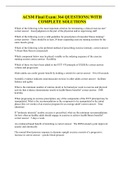
-
ACSM Final Exam| 364 QUESTIONS| WITH COMPLETE SOLUTIONS
- Exam (elaborations) • 24 pages • 2022
-
Available in package deal
-
- $12.49
- + learn more
Which of the following is the most important criterion for terminating a clinical exercise test? correct answer: Good judgment on the part of the physician and/or supervising staff Which of the following is not a valid guideline for prescription of muscular fitness training? correct answer: There should be at least 24 hours separating exercise training sessions for the same muscle group Which of the following is the preferred method of prescribing exercise intensity. correct answer: % H...

-
ACSM Exam 1 || A+ GRADED.
- Exam (elaborations) • 13 pages • 2024
- Available in package deal
-
- $11.99
- + learn more
ACSM correct answers American College of Sports of Medicine AHA correct answers American Heart Association Certifications for ACSM correct answers - CPT, EP-C* - Clinical Exercise Specialist - Nat'l Strength and Conditioning Association (CSCS) - Aerobics & Fitness Association of America (AFAA) - American Council on Exercise (ACE) How do I get certified for ACSM? correct answers - A minimum of a bachelor's degree in EXS or related field (may take exam during final semester) - Curr...

-
ACSM GEI Practice Exam 1 Questions and Answers Rated A+
- Exam (elaborations) • 44 pages • 2024
- Available in package deal
-
- $11.49
- + learn more
ACSM GEI Practice Exam 1 Questions and Answers Rated A+ Muscle imbalances are generally the major causes of poor posture including all of the following except A. inherited conditions B. habits from occupational or repetitive movements C. disease D. leg lifts D. Leg Lifts To teach a stationary lunge, use all of the following cues except: A. stand with feet about 3 feet apart B. lift onto the ball of the back foot C. place the pelvis forward D. hips and shoulders are level ...
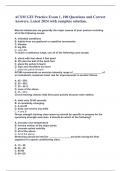
-
ACSM GEI Practice Exam 1, 100 Questions and Correct Answers, Latest 2024 with complete solution.
- Exam (elaborations) • 17 pages • 2024
-
- $13.49
- + learn more
ACSM GEI Practice Exam 1, 100 Questions and Correct Answers, Latest 2024 with complete solution. Muscle imbalances are generally the major causes of poor posture including all of the following except A. inherited conditions B. habits from occupational or repetitive movements C. disease D. leg lifts D. Leg Lifts To teach a stationary lunge, use all of the following cues except: A. stand with feet about 3 feet apart B. lift onto the ball of the back foot C. place the pelvis forwa...

-
ACSM GEI Practice Exam 1 Lates 2024 with complete solution
- Exam (elaborations) • 17 pages • 2024
-
- $11.99
- + learn more
ACSM GEI Practice Exam 1 Lates 2024 with complete solution Muscle imbalances are generally the major causes of poor posture including all of the following except A. inherited conditions B. habits from occupational or repetitive movements C. disease D. leg lifts D. Leg Lifts To teach a stationary lunge, use all of the following cues except: A. stand with feet about 3 feet apart B. lift onto the ball of the back foot C. place the pelvis forward D. hips and shoulders are level C...
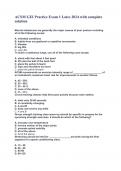
-
ACSM GEI Practice Exam 1 Lates 2024 with complete solution
- Exam (elaborations) • 17 pages • 2024
-
- $12.99
- + learn more
ACSM GEI Practice Exam 1 Lates 2024 with complete solution Muscle imbalances are generally the major causes of poor posture including all of the following except A. inherited conditions B. habits from occupational or repetitive movements C. disease D. leg lifts D. Leg Lifts To teach a stationary lunge, use all of the following cues except: A. stand with feet about 3 feet apart B. lift onto the ball of the back foot C. place the pelvis forward D. hips and shoulders are level C...

-
ACSM Exam 1 questions with correct answers
- Exam (elaborations) • 24 pages • 2023
- Available in package deal
-
- $13.49
- + learn more
ACSM Answer American College of Sports of Medicine AHA Answer American Heart Association Certifications for ACSM Answer - CPT, EP-C* - Clinical Exercise Specialist - Nat'l Strength and Conditioning Association (CSCS) - Aerobics & Fitness Association of America (AFAA) - American Council on Exercise (ACE) How do I get certified for ACSM? Answer - A minimum of a bachelor's degree in EXS or related field (may take exam during final semester) - Current certification in adult CPR/AED w...
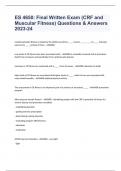
-
ES 4650: Final Written Exam (CRF and Muscular Fitness) Questions & Answers 2023-24
- Exam (elaborations) • 18 pages • 2023
-
Available in package deal
-
- $9.99
- + learn more
ES 4650: Final Written Exam (CRF and Muscular Fitness) Questions & Answers 2023-24 Cardiorespiratory fitness is related to the ability to perform ____ muscle, ____, ____-to-____ intensity exercise for ____ periods of time. - ANSWER- Low levels of CR fitness have been associated with: - ANSWER-a markedly increased risk of premature death from all causes and specifically from cardiovascular disease Increases in CR fitness are associated with a ____ from all causes. - ANSWER-reduction in...
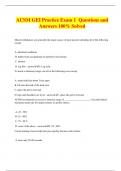
-
ACSM GEI Practice Exam 1 Questions and Answers 100% Solved
- Exam (elaborations) • 25 pages • 2024
- Available in package deal
-
- $13.49
- + learn more
ACSM GEI Practice Exam 1 Questions and Answers 100% Solved Muscle imbalances are generally the major causes of poor posture including all of the following except A. inherited conditions B. habits from occupational or repetitive movements C. disease D. leg lifts - answerD. Leg Lifts To teach a stationary lunge, use all of the following cues except: A. stand with feet about 3 feet apart B. lift onto the ball of the back foot C. place the pelvis forward D. hips and shoulders are level -...
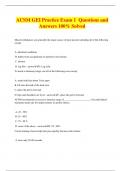
-
ACSM GEI Practice Exam 1 Questions and Answers 100% Solved
- Exam (elaborations) • 25 pages • 2024
- Available in package deal
-
- $13.49
- + learn more
ACSM GEI Practice Exam 1 Questions and Answers 100% Solved Muscle imbalances are generally the major causes of poor posture including all of the following except A. inherited conditions B. habits from occupational or repetitive movements C. disease D. leg lifts - answerD. Leg Lifts To teach a stationary lunge, use all of the following cues except: A. stand with feet about 3 feet apart B. lift onto the ball of the back foot C. place the pelvis forward D. hips and shoulders are level -...

$6.50 for your textbook summary multiplied by 100 fellow students... Do the math: that's a lot of money! Don't be a thief of your own wallet and start uploading yours now. Discover all about earning on Stuvia


